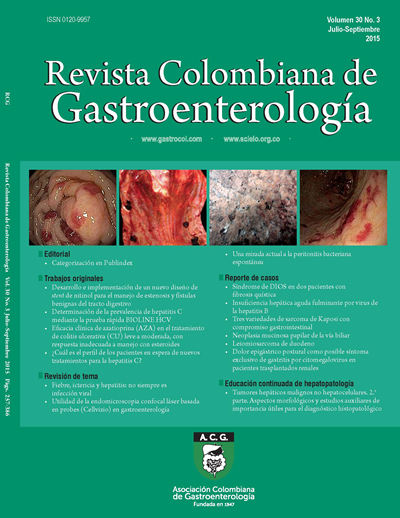Fiebre, ictericia y hepatitis: no siempre es infección viral
DOI:
https://doi.org/10.22516/25007440.54Keywords:
Hepatitis, Salmonella, fiebre entéricaAbstract
La fiebre tifoidea es una infección sistémica causada por Salmonella entérica serotipo tiphy a través de la ingesta de alimentos contaminados (fecal-oral). Es un problema de salud pública, especialmente en países en vías de desarrollo, debido a su alta prevalencia, relacionada con deficiencias sanitarias. En pacientes con fiebre tifoidea, la hepatitis se presenta en 1% a 26% de los pacientes y se debe sospechar cuando coexisten ictericia, fiebre y hepatitis. No obstante ser difícil de distinguir de las hepatitis por virus hepatotrópicos, la clave para el diagnóstico es que, en estas infecciones virales, la fiebre desaparece cuando el paciente presenta ictericia. El diagnóstico final de la entidad necesita el aislamiento de la Salmonella a través de coprocultivos y hemocultivos, especialmente de la médula ósea, que es el sitio con mayor rendimiento para el diagnóstico.
Downloads
References
Karoli R, Fatima J, Chandra A, Singh G. K hepatitis: An uncommon complication of a common disease. J Fam Med Prim care. 2012;1(2):160-2.
Pramoolsinsap C, Viranuvatti V. Salmonella hepatitis. J Gastroenterol Hepatol. 1998;13:745-50.
Ahmed A, Ahmed B. Jaundice in typhoid patients: Differentiation from other common causes of fever and jaundice in the tropics. Ann Afr Med. 2010;9(3):135-40.
Parry CM, Hien TT, Dougan G, White NJ, Farrar JJ. Typhoid fever. N Engl J Med. 2002;347(22):1770-82.
Wain J, Hendrikse R, Mikoleit ML, Keddy KH, Ochiai R. Typhoid fever. Lancet. Elsevier Ltd. 1981;79(panel 1):791-3.
Otero W. Hepatitis con ictericia y fiebre. Syllabus 1er Curso Internacional de Medicina Tropical y Enfermedades olvida- das. Universidad Nacional de Colombia e Instituto Suizo de Medicina Tropical. 2007
Huang DB, DuPont HL. Problem pathogens: Extraintestinal complications of Salmonella enterica serotype Typhi infection. Lancet Infect Dis. 2005;5:341-8.
Instituto Nacional de Salud. Comportamiento epide- miológico de la vigilancia de fiebre tifoidea y paratifoi- dea en Colombia, 2011. Inf Quinc Epidemiológico Nac. 2013;18(16):164-74.
Parry CM, Thompson C, Vinh H, Chinh NT, Phuong LT, Ho VA, et al. Risk factors for the development of severe typhoid fever in Vietnam. BMC Infect Dis. 2014;14(1):73. 10. Albayrak A, Gunbey SS, Aktas F. Cholestatic hepatitis due to Salmonella typhi. Clin Pract. 2011;1(313):22-3.
Husain EH. Fulminant hepatitis in typhoid fever. J Infect Public Health [Internet]. King Saud Bin Abdulaziz University for Health Sciences. 2011;4(3):154-6.
Ratnayake EC, Shivanthan C, Wijesiriwardena BC. Cholestatic hepatitis in a patient with typhoid fever - A case report. Acta Gastroenterol Belg. BioMed Central Ltd. 2012;75(1):65.
Longo D, Kasper D, Jameson JL, Fauci AS, Hauser SL, Loscalzo J. Harrison Principios de Medicina Interna. 18.a edición. 2012.
Dougan G, Baker S. Salmonella enterica Serovar Typhi and the pathogenesis of typhoid fever. Annu Rev Microbiol. 2014;68:317-36.
De Jong HK, Parry CM, Van der Poll T, Wiersinga WJ. Host-pathogen interaction in invasive salmonellosis. PLoS Pathog. 2012;8(10):1-9.
Waddington CS, Darton TC, Woodward WE, Angus B, Levine MM, Pollard AJ. Advancing the management and control of typhoid fever: A review of the historical role of human challenge studies. J Infect.Elsevier Ltd. 2014;68(5):405-18.
Waddington CS, Darton TC, Pollard AJ. The challenge of enteric fever. J Infect. Elsevier Ltd. 2014;68:S38-50.
Rungta N, Singhi S, Chaudhary D, Varghese G, Bhalla A, Karthi N, et al. Tropical fevers: Management guidelines. Indian J Crit Care Med. 2014;18:62.
Khosla SN. Typhoid hepatitis. Postgraduated Med J. 1990;66:923-5.
Nadhim Younis S. The role of abdominal ultrasound in the diagnosis of typhoid fever: An observational study. Travel Med Infect Dis. Elsevier Ltd. 2013;1-4.
Darton TC, Blohmke CJ, Pollard AJ. Typhoid epidemio- logy, diagnostics and the human challenge model. Curr Opin Gastroenterol. 2014;30:7-17.
Bathia S, Prabhu M, Saravu M, Docherla B. Spectrum of hepatic dysfunction in enteric fever. Int J Infect Dis. 2010;14:e214-5.
Isa SE, Onyedibe KI, Okolo MO, Abiba AE, Mafuka JS, Simji GS, et al. A 21-year-old student with fever and pro- found jaundice. PLoS Negl Trop Dis. 2014;8(1):3.
Schindler M, Kreplak N, Acevedo L, Damis H, Marquez G, Ardaiz M. Ictericia febril colestásica como forma de presentacion de linfoma de Hodgkin. Med Buenos Aires. 2014;74:60-1.
Zimhony O, Katz M. A patient with fever and jaundice.
QJM. 2012;105:381-2.
Madrid M, Huguet J. Enfermedades hepáticas infecciosas.
GH Contin. 2006;5:218-21.
WHO. Background document : The diagnosis, treatment and prevention of typhoid fever. Commun Dis Surveill Response Vaccines Biol. 2003.
Tatavarthy A, Luna V, Amuso PT. How multidrug resistance in typhoid fever affects treatment options. Ann N Y Acad Sci. 2014;1323:76-90.
Zaki S, Karande S. Multidrug-resistant typhoid fever: A review. J Infect Dev Ctries. 2011;5(5):324-7.
Thaver D, Zaidi AKM, Critchley J, Azmatullah A, Madni SA, Bhutta Z. Fluoroquinolones for treating typhoid and para- typhoid fever (enteric fever). Cochrane Database Syst Rev. 2008;(10).
Thaver D, Zaidi AKM, Critchley J, Azmatullah A, Madni SA,
Bhutta Z. A comparison of fluoroquinolones versus other antibiotics for treating enteric fever: meta-analysis. BMJ. 2009;338:b1865.
Drlica K, Zhao X. DNA gyrase, topoisomerase IV, and the 4-quinolones. Microbiol Mol Biol Rev. 1997;61:377.
Koirala S, Basnyat B, Arjyal A, Shilpakar O, Shrestha K, Shrestha R, et al. Gatifloxacin versus ofloxacin for the treatment of uncomplicated enteric fever in nepal: an open- label, randomized, controlled trial. PLoS Negl Trop Dis. 2013;7(10).
Trivedi N, Shah P. A meta-analysis comparing the safety and efficacy of azithromycin over the alternate drugs used for treatment of uncomplicated enteric fever. J Postgr Med. 2012;58(2):112-8.
Downloads
Published
How to Cite
Issue
Section
License
Aquellos autores/as que tengan publicaciones con esta revista, aceptan los términos siguientes:
Los autores/as ceden sus derechos de autor y garantizarán a la revista el derecho de primera publicación de su obra, el cuál estará simultáneamente sujeto a la Licencia de reconocimiento de Creative Commons que permite a terceros compartir la obra siempre que se indique su autor y su primera publicación en esta revista.
Los contenidos están protegidos bajo una licencia de Creative Commons Reconocimiento-NoComercial-SinObraDerivada 4.0 Internacional.




















